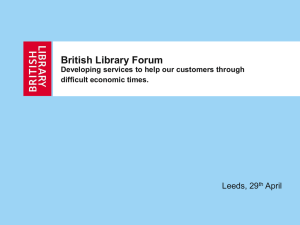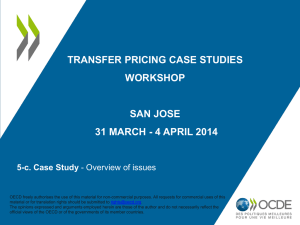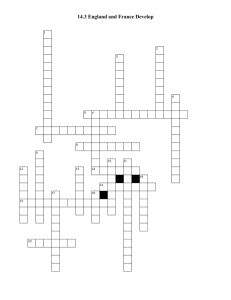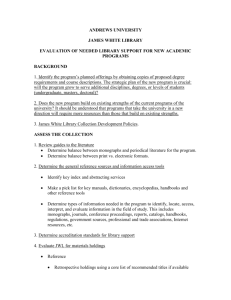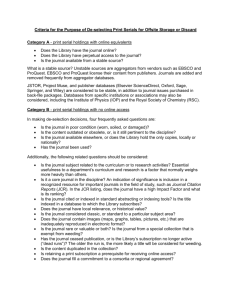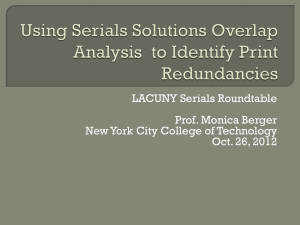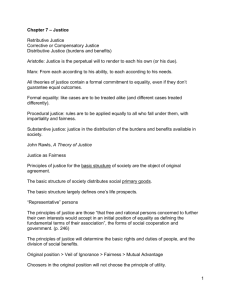UKRR_Article-Final_draft - Spiral
advertisement
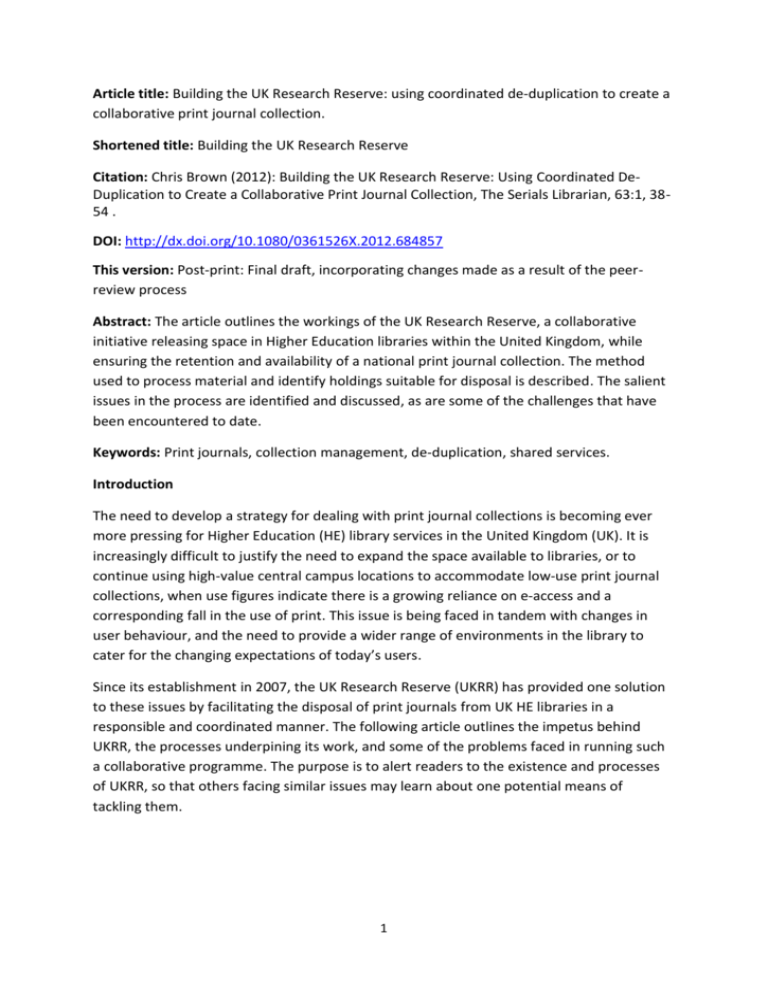
Article title: Building the UK Research Reserve: using coordinated de-duplication to create a collaborative print journal collection. Shortened title: Building the UK Research Reserve Citation: Chris Brown (2012): Building the UK Research Reserve: Using Coordinated DeDuplication to Create a Collaborative Print Journal Collection, The Serials Librarian, 63:1, 3854 . DOI: http://dx.doi.org/10.1080/0361526X.2012.684857 This version: Post-print: Final draft, incorporating changes made as a result of the peerreview process Abstract: The article outlines the workings of the UK Research Reserve, a collaborative initiative releasing space in Higher Education libraries within the United Kingdom, while ensuring the retention and availability of a national print journal collection. The method used to process material and identify holdings suitable for disposal is described. The salient issues in the process are identified and discussed, as are some of the challenges that have been encountered to date. Keywords: Print journals, collection management, de-duplication, shared services. Introduction The need to develop a strategy for dealing with print journal collections is becoming ever more pressing for Higher Education (HE) library services in the United Kingdom (UK). It is increasingly difficult to justify the need to expand the space available to libraries, or to continue using high-value central campus locations to accommodate low-use print journal collections, when use figures indicate there is a growing reliance on e-access and a corresponding fall in the use of print. This issue is being faced in tandem with changes in user behaviour, and the need to provide a wider range of environments in the library to cater for the changing expectations of today’s users. Since its establishment in 2007, the UK Research Reserve (UKRR) has provided one solution to these issues by facilitating the disposal of print journals from UK HE libraries in a responsible and coordinated manner. The following article outlines the impetus behind UKRR, the processes underpining its work, and some of the problems faced in running such a collaborative programme. The purpose is to alert readers to the existence and processes of UKRR, so that others facing similar issues may learn about one potential means of tackling them. 1 The UKRR Research Reserve: an overview The UK Research Reserve is a collaborative programme which intends to protect and enhance the UK’s research infrastructure, while simultaneously releasing space occupied by low-use print journals held in HE libraries. UKRR Phase 2 began in February 2009, and has been granted a total of £9.83 million from the Higher Education Funding Council for England (HEFCE), with the intention of releasing 100 kilometres of shelf space during its 5 years of activity. Prior to 2009 a pilot project, now known as UKRR Phase 1, ran from January 2007 to September 2008, and involved 8 HE institutions working in partnership with the British Library (BL), to test the underlying concepts and need for a collaborative venture dealing with legacy print collections . Aside from its success in releasing around 11 kilometres of shelf space, Phase 1 developed the principles underlying UKRR into workable processes, and identified issues that Phase 2 would need to address in order to be successful. Further information about Phase 1 can be found in articles by Shorley1, Wright and Crawford2, and Crawford3. The seemingly contradicting objectives of protecting access to research material while releasing a large amount of shelf space, is achieved through the provision of funding to libraries that have joined UKRR, based on the amount of material they submit. The funding provided covers the costs incurred by members participating in the UKRR process, including any eventual disposal of material. Although at first it may appear counterproductive to provide funding to facilitate disposal, when the intention is to protect print journal holdings, the funding provides an incentive for members to participate in UKRR’s coordinated disposal process, rather than seek to dispose of their journal collections in isolation. Through the UKRR process, only holdings found to be held in two other participants’ collections are cleared for disposal, with any others marked as a UKRR retained holding, forming part of a distributed national research collection. UKRR is thus a means of reducing duplication within the collective holdings of all members, while ensuring the retention of an identifiable national collection of print journals. The resulting distributed collection is not just a means of sharing the burden of retaining low use print journals, but also a step towards changing the culture in UK libraries, through the promotion of a collaborative view of collections that transcends institutional boundaries. The collation of a significant, accessible, research collection is furthered by the partnership underlying UKRR: that between the HE sector and the BL. The role of the BL in UKRR is central to providing access to the content of the print journals in the research reserve, via the British Library Document Supply Centre (BLDSC) based at Boston Spa, West Yorkshire; and the reading rooms at Boston Spa and St. Pancras, Central London. Funding available through UKRR has been used to help finance the development of an Integrated Request Management and Delivery System (IRMDS), which will streamline the BL’s document supply processes, leading to improved efficiency and a better service for 2 researchers. Further funding available through UKRR supports the manual checking of the BL’s print holdings for every issue of every journal offered by the HE libraries which belong to UKRR. Issues offered by members that would complete any gaps in the BL’s collection are requested for transfer from the HE library to the BL, thus improving the completeness of the document supply collection. Although members make a contribution to the cost of holding the UKRR collection at the BL through payment of an annual subscription fee, the completed holdings at the BL are available to satisfy all document requests received by the BL, not just those from UKRR members. Thus the combination of material transferred from UKRR members to the BL, and the access infrastructure (IRMDS) funded through the initiative enhances both the pool of content available to the UK research community, and the means of delivering it. Although it is both unthinkable and highly unlikely that the print collections of the BL should ever be lost to the research community, UKRR takes a suitably cautious approach to reducing print holdings. The improved holdings of the BL, coupled with the enhanced supply systems supported by IRMDS, represent the access copy for the research community. The two further copies which must be identified within the collections of UKRR members before material is cleared for disposal represent preservation copies, which serve as insurance for the continued availability of print journal content. Any items offered to UKRR which are identified as having less than two remaining copies within the membership are marked for retention, and identified as a UKRR holding through the addition of a public note in the item’s catalogue record. All holdings at the BL whose completeness have been checked as a result of the UKRR process, are also marked as UK Research Reserve titles. In order to further improve access to content for researchers at UKRR member libraries, a preferential document delivery service is provided for all requests supplied by the BL. Requests are submitted via the usual channels and given priority status by the BL who have undertaken to respond within 24 hours, often directly to the user using an email branded with the member institution’s details. So while the physical item may no longer reside within the collection of the researchers’ institution, there may be little difference in the time taken to access the content of the item, beyond what could be reasonably anticipated if it had been stored in a closed access area or off-site. Direct to desktop provision of print content in this manner meets the preferences and demands of many researchers, who have become accustomed to the convenience of accessing digital content4 . The funding paid to both the BL and member libraries is based on the amount of shelf space occupied by the holding offered by the member library. As much of the work involved in processing a holding occupying two metres is the same as one occupying 0.20 metres, the rates have been determined based on an average of 1 title per 1 linear metre of shelf space. It is interesting to note that although some members have a title/metre ratio which averages under 1/0.40, across UKRR to date the figure is in excess of 1/1.2. Funding 3 for staff running UKRR, a manager and data coordinator, both based at the lead institution Imperial College London, is paid centrally and is not related to the amount of material processed. The UKRR process Despite the process underlying UKRR being relatively simple, any description of it can come across as complex due to the various data exchanges and checks that take place, and the terminology used to refer to the various data items. To assist the reader’s understanding, figure 1 shows a workflow diagram of the UKRR process, and a glossary of UKRR terms is supplied as an appendix to this article. At the heart of the UKRR process is the principle of releasing shelf space, by removing journal holdings duplicated within the collections of the 29 member libraries. To coordinate this, UKRR uses a decision support system known as LARCH (Linked Automated Register of Collaborative Holdings). Developed in 2010, LARCH has been designed to specifically meet the data management and processing needs of UKRR, and provide decision support functionality to coordinate and inform the de-duplication process. LARCH is essentially a database holding the bibliographic and holdings data relating to members’ offered holdings, details of issues requested for transfer to the BL, and data used to inform the UKRR process. Accessible to all UKRR partners and members via a web interface, it acts as a central authoritative source of information for those involved in the operation of UKRR processes. The purpose of LARCH is not to function as a catalogue for the research reserve, as this role is best served by existing union catalogues, but to coordinate the process of determining what material can be disposed of, and what should be retained. The de-duplication process is initiated when member libraries identify holdings suitable for removal from their collection. Typically journals available electronically through established services such as JSTOR or the ACM archive, or titles in STM disciplines where a greater proportion of the back run is available electronically,5 are most popular. The ten most popular journals offered to date are shown in Table 1. Submission of holdings to UKRR is typically through completion of a Microsoft Excel spreadsheet, which has fields for all the data required to match the holdings being offered to the holdings of both the BL and other UKRR members. Submissions must include basic bibliographic details for the holding, as well as details of the start and end issues, and any gaps in the holding. As members tend to work with lists of journals they have identified as suitable for submission to UKRR, and these lists may contain anything from a handful of holdings to thousands, the spreadsheet format facilitates the sorting and filtering of material as the list is collated. It also allows insertion of columns to hold data relating to the process at the member library end, which although not relevant to UKRR processes, will be included in the final report to the member library from UKRR. Once the list of holdings is 4 Figure 1. The UKRR process. The top section shows the overall process, while the bottom details how retention statuses are determined. 5 Journal Biochimica et biophysica acta (including all sections published under varying titles) Journal of the Statistical Society / Journal of the Royal Statistical Society / Journal of the Royal Statistical Society. Series A (General) / Journal of the Royal Statistical Society. Series A (Statistics in Society) British journal of applied physics / British journal of applied physics. Journal of physics D / Journal of physics. D, applied physics Journal of the Chemical Society / Journal of the Chemical Society. C. Organic / Journal of the Chemical Society. Perkin transactions I Journal of physics A, Mathematical and general / Journal of physics A: general physics / Journal of Physics A: mathematical & theoretical / Journal of physics. A, mathematical nuclear and general Journal of memory and language / Journal of verbal learning and verbal behavior Bell journal of economics / Bell journal of economics and management science / Rand journal of economics / Proceedings of the Physical Society / Proceedings of the Physical Society of London / Proceedings of the Physical Society. Section A / Proceedings of the Physical Society. Section B / Clinical neurophysiology / Electroencephalography and clinical neurophysiology / Electroencephalography and clinical neurophysiology evoked potentials / Electromyography and motor control / Europe-Asia studies / Soviet studies / No. of times offered 53 33 30 29 28 26 25 25 24 24 Table 1: Journals most frequently offered to UKRR. completed, staff at the member library upload the spreadsheet to LARCH, and the data is extracted from the former to the latter. At this point validation rules are automatically applied to the bibliographic and holdings data to check for the following: Title ISSN, or if unavailable both publisher and place of publication At least 1 piece of holdings data 6 Shelf measurement for the holding The validation rules ensure a bare minimum of data relating to the item being offered is present. The requirement for a shelf measurement is due to this being the metric upon which the funding paid to the member and the BL is based. The validated data is submitted once the user has reviewed it using the web-based user interface. Submissions that fail validation result in an email to the user listing the validation errors, . After correction the list is uploaded again. Records orf offered holdings can also be created in LARCH through the user interface, in which case the validation rules are applied when these records are saved. The list is submitted to UKRR for processing once the member library user has loaded the list to LARCH, and performed a final review of the data on it. Staff at the BL then download the data, and a dedicated team physically checks their print holdings to identify any material offered that is not already held in their document supply collection. These checks result in a file identifying any material required by the BL to complete their holdings, or requesting a sample should it not be possible to match the offered holding to a title held at the BL, which is subsequently loaded into LARCH. A sample request generates an email sent from LARCH to the offering library requesting an issue of the journal be sent to the BL, with the email also acting as a packing slip for the item. If necessary a second file with responses to any items requested as samples is provided by the BL once processing of them is complete. An important aspect of the role performed by the BL as part of their processing is the checking and amending of the holdings data provided by member libraries. As the BL shelf checking confirms the holdings data against a physical copy of the item, a mismatch will generate a query to the offering library regarding the title and holdings on offer. The result of such a query often leads to an amendment to the bibliographic or holdings data of the offering, which will be included in the file uploaded by the BL and will overwrite the existing (incorrect) data for that holding in LARCH. While the shelf checking at the BL is taking place, the holdings of the other 28 member libraries are checked and any holdings duplicating the material on offer are identified. The resulting data from this is used to inform decisions on the disposal and retention of the material on offer. This process has two stages, and begins with the ISSN and title details being forwarded to the SUNCAT team at EDINA. EDINA1 is a national academic data centre based at the University of Edinburgh and hosts the SUNCAT2 serials union catalogue, which provides details of other holdings of the offered title, available within UKRR member collections. Although two UKRR member libraries do not contribute their 1 http://www.edina.ac.uk http://www.suncat.ac.uk/ 2 7 holdings to SUNCAT, EDINA staff are able to use the Z39.50 targets of their library’s catalogues to extract holdings data and combine this with the SUNCAT results. The title level holdings data resulting from these searches is then passed to the UKRR team at the BL, who manually compare the issues in the offered holding and those available in other UKRR member libraries. The resulting data is then returned to UKRR in the form of codes representing any member libraries that have a complete match for the holding on offer. In UKRR circles the codes relating to the offered holding and the number of them are referred to as scarcity data, while the total number of codes associated with each holding is referred to as the scarcity count. The scarcity count is the salient metric in determining whether the offering library is given clearance to dispose of the holding, or asked to retain it for the research reserve, as it represents the sum of duplicate copies identified within the amassed collections of UKRR members. UKRR are able to determine the final retention status (UKRR parlance for a dispose/retain decision) of the offered holding by combining the scarcity data and details of issues required by the BL to complete their holdings. At this point LARCH shows its value as a decision support tool, with any holding with a scarcity count of two of more (i.e. available in two other members’ collections) being marked for disposal, and details of issues requested by the BL provided in tandem to this. Any item with a scarcity count of zero or one will be marked for retention as a preservation copy for the research reserve, with details of any issues requested by the BL provided alongside this. In determining the retention status of offered holdings, UKRR’s role is to ensure that disposal decisions are coordinated, and not all copies of a given journal are simultaneously cleared for disposal. To facilitate this all holdings offered to UKRR are matched to a central master list of journals within LARCH, which underlies functionality in the system drawing together the retention statuses applied to other holdings matched to the same master list item. The master list item to which the offered holding is matched is determined by the journal the BL have checked their holdings against, with one master list item representing the entire published history of the journal. This can be seen in table 1 where all the items listed have undergone title changes, but are still considered to be the same journal. Treating journals in this way overcomes the issues caused by members offering holdings runs which span a change in title, which would cause problems if the holding had to be linked to both former and continuing titles. The functionality supported by the master list automatically recalculates the scarcity count, based on any correlation between the libraries named in the scarcity data, and any libraries that have previously offered a holding to UKRR which is linked to the same master list record. Any member library in this category will be automatically discounted from the total number of libraries in the scarcity data to produce an “adjusted scarcity” count, which is then used to determine the retention status for the holding. Should the difference between the actual scarcity and adjusted scarcity cross the threshold of two, at which point 8 it would cause the retention status of the item to switch from dispose to retain, LARCH requires a manual intervention on the item. The requirement for a manual intervention caters for instances where the issues in the holding previously offered to UKRR may not overlap with the issues in the holding whose retention status is being determined; or where the holding previously offered has been retained and is thus already acting as one of the two preservations copies UKRR is ensuring the retention of. In both cases such holdings can be excluded from the adjusted scarcity recalculation, and the retention status of the offered holding adjusted accordingly, with a note left by the reviewer explaining the reasons for the decision they have made. Before the retention statuses can be finalised and made available to the member library, all offered holdings on the list must meet the following criteria: They must have been responded to by the BL Have scarcity data Have been matched to the master list Have had any items where the difference between the full scarcity and adjusted scarcity counts has affected the retention status reviewed. These criteria ensure the decisions made by UKRR are based on the presence of all the data that could affect the retention status, and that potential impacts on the data resulting from decisions taken previously are taken into account. Once the whole list has been processed it is finalised, and the member library receives an email alert summarising the overall levels of retention and disposal. Staff at the member library can then download the retention statuses for the list from LARCH as a report in Excel, CSV or xml format. Libraries are free to act upon the retention decisions within their own timescale, which allows for the timing of the physical processes of disposal and shelving adjustments, moving of retained stock, and the repurposing of space, so that they cause minimum disruption to library users. The final stage in the process is for the bibliographic records of retained items to be marked as UKRR copies using a pre-agreed MARC tag, and the removal of holdings records for items that have been disposed. Data challenges in de-duplicating multiple collections By far the most resource-intensive aspect of the process undertaken by UKRR is the scarcity check: a manual comparison between the issues in the offered holding and the holdings available within other UKRR members’ collections. As the number of matching holdings identified through the scarcity check process depends on the issues contained in the offered holding, the data is not transferrable from one holding to another even if they are the same journal. Consequently the full searching and manually matching process must be undertaken for each holding offered to UKRR. Although the first stage of the process 9 which searches for holdings of the journal within other UKRR member libraries is automated, the lack of consistency in the holdings data available from member libraries is a barrier that prevents the second half of the process being automated to. Example of holdings data received from member libraries Library 1 Library 2 Library 3 Library Library Library Library Library Library Library a b c d e f g Journal of Economic Literature v. 7 no. (1969) to v. 45 no. (2007) Journal of Economic Literature v. no. (1969) to v. no. (2000) Journal of economic literature v. 38 no. 1 (2000) to v. 45 no. 4 (2007) Example of holdings data for Journal of Economic Literature (taken from SUNCAT and reflecting local cataloguing practice) Library has v. 39, no. 1 (Mar. 2001)Vol.7- 41, 1969-2003 Vol. 7- (1969-) Vols 1-6 (1963-68) 7(1969)-25(1987), 26(1988), 27(1989)Vol 7-32, 1969-94, Vol 33- , 1995- (incomplete) v.7:no.1(1969:MAR)8-17/1970-1979, 18-38/1980-2000, 39-47/2001-2009 Table 2. Examples of the variation in holdings data provided in submissions to UKRR, and available from participating libraries via SUNCAT. The top section of Table 2 shows the variation in holdings format for some of the submissions of the Journal of Economic Literature received by UKRR. The relative consistency shown here is a result of the template used for submission to LARCH which requires the enumeration and chronology for the holding to be entered into separate columns. The identifiers v. , no., and () in the holdings data is inserted automatically by LARCH, and the actual data provided to UKRR by members is only the numbers less these. What can be seen however is that not all members are able to give complete details of their holdings to the issue, or even volume level, either as a result of not having this data stored in their catalogues or not having access to items in off-site storage. However, a greater challenge to an automated comparison of holdings comes from the data provided to SUNCAT by UKRR member libraries, as shown in the lower section of table 2. It is against this data that the offered holdings such as those shown in the top half of table 2 must be matched to, in order to identify holdings which contain the same issues. The format of the holdings data reflects the variation in local cataloguing practice, and it is evident that there is little standardisation in the way holdings are recorded from one library to the next. A key step in automating the second half of the scarcity checking process would necessitate extracting members’ holdings data into a consistent format to allow a comparison between this data and that provided in the members’ submission. When 10 combined with the incomplete nature of the data provided in the submission template, this presents a barrier to removing the need for manual interpretation and comparison. Historic cataloguing practice can further complicate the comparison process, especially if a participating library has failed to identify changes in the publication history of the title, so that the bibliographic data provided with their submission does not match all the holdings they have submitted. An example is shown in table 3 where the details of an offering of Physical Review A are given along with the various changes of title for this journal. In this case despite a manual search of SUNCAT identifying seven other member libraries which held the offered issues, no complete matches were identified during the scarcity checking process as a result of the initial automated search being conducted using the ISSN provided by the offering library. As the ISSN search is only performed against the |a subfield of the MARC 022 tag, only bibliographic records for which this was the correct ISSN were retrieved, and these records were for the title published from 1990 onwards with their corresponding holdings records. The first part of the offered holding, published prior to 1990, was found to be missing from the holdings retrieved by the search, so no complete matches for the offered holding were identified resulting in a scarcity count of zero. Although it would be possible to include the holdings of former and continuing titles in the search results by also gathering those records where the ISSN features in the other subfields of the MARC 022 tag , this would complicate the process by including incorrect titles such as Physical Review E in the example below, which continues the enumeration of its predecessor but is a separate journal in its own right. As only the holdings and not the bibliographic details are retrieved by the search, there is potential to gather incorrect holdings should the search criteria not remain sufficiently focused to capture only those titles which are a genuine match for the offered holding. Offered holding from member library ISSN 1050-2947 Title Physical Review A Holdings v. 1 no. 1 (1970) to v. 74 no. 6 (2006) Publication history of Physical Review A ISSN 0556-2791 Title Physical review. A, General physics 1050-2947 1063-651X Physical Review A Physical Review E (split from Physical Review A, but continued enumeration) Physical review. E, Statistical, nonlinear, and soft matter physics 1539-3755 Publication history v. 1 no. 1 (1970) to v. 40 no. 12 (1989) v. 41 no.1 (1990) onward v. 47, no.1 (Jan. 1993)-3rd ser., v. 62, no. 6, pt. B (Dec. 2000) 3rd ser., v. 63, no.1 (Jan. 2001) onward 11 Table 3. Example of an offered holding received by UKRR, along with details of the publication history of the journal. One noteworthy aspect of the above processes, is the way the material in the offered holding is matched against the BL’s holding to the level of the individual issue, while matching to other libraries’ collections (i.e. the scarcity check) is done based on the whole holding. This is owing to the depth of holdings data that would be required from members to match individual offered issues to others held in UKRR members’ collections. Such a process would be dependent on the offering library providing a record for each individual issue of each holding offered to UKRR, and a corresponding issue-specific record being made available by the remaining twenty-eight members. This would probably amount to a complete shelf-check of all holdings within the 29 members, and the collation of a comprehensive record of the holdings discovered by the checks. Compiling such a record manually would be a task so resource intensive as to be uneconomical when compared to the savings that will be made by releasing shelf space through UKRR. The retrospective automated compilation of a comprehensive holdings record, through the use of an issue prediction function as is available in most library management system, would also be difficult. Changes in bibliographic details, inconsistent numbering, variation in publication frequency, and breaks in publication tend to disrupt any machine identifiable patterns of publication and would warrant frequent manual interventions. The success of such a process would also be dependent on the holdings of all 29 members being dealt with using exactly the same procedure, which would be difficult to coordinate if not performed centrally. Using the existing journal holdings data available from members through their catalogues and contributions to SUNCAT, while still intensive, is a comparatively easier and cheaper process which still produces real benefits to UKRR libraries. Building a collection through disposal: a new way of thinking Along with releasing space, central to UKRR is the principle of identifying journal holdings which are found to be scarce, and retaining them as part of a national print collection. However the UKRR process is in stark contrast to the established method of building a library collection, a result of those apparently conflicting goals of disposing and protecting print journal holdings. In the traditional model of collection building, material not held is identified and acquired through purchase, subscription, or donation. This is the process followed by libraries in their acquisition of material for their collections, and also in the work at the BL to complete their holdings from the material offered by UKRR members. UKRR takes its starting point as the combined collections of all member libraries, as they are 12 already “complete” in the respect of them being significant print journal holdings and unlikely to be improved further. It then follows a process that removes duplication through the disposal of holdings nominated by a member library. Assuming the number of other copies available within the membership meets the threshold of two, the holding will be cleared for disposal. The choice of such a different collection model reflects some of the underlying principles of UKRR. Foremost amongst these is that UKRR should supply a means of coordinated and informed disposal of legacy print journal collections. Determining duplication between the offered holding and the amassed collections of all members increases the level of disposal when compared with what would be achievable by other collection building methods. To date over 76% of the titles offered to UKRR in phase 2 have been cleared for disposal, and although accurate figures for a more traditional collection model are difficult to ascertain due to the complexity surrounding the overlap between holdings, if two copies of every title offered so far had been retained then the disposal level would have been below 44%. That the current 76% disposal level represents around 85% of the total of shelf measurements offered to date confirms that the UKRR model is meeting its goal. Providing responses in good time is paramount to UKRR’s success in meeting the needs of participating libraries. The first list submitted to UKRR Phase 2 came from a library faced with a structural weakness in its main library building, which necessitated the urgent removal of a large amount of the journal stock stored there. Many subsequent submissions from other members have been driven by similar needs, usually through the loss of storage space or the need to alter facilities within the library building to cater for changing user requirements. If the UKRR collection were being built using the traditional model whereby the first time issues of a journal were offered they were marked as the retention copies, then UKRR would not be able to cater for the needs of such libraries requiring a means of quick but informed disposal. Conversely the model allows members to retain existing collection strengths in specific subject areas by not offering this material for disposal. The existence of these holdings and their appearance in the scarcity data facilitates the removal of other copies of the same journal held within the membership, which may be imperfect or short runs of less value to the local and national collection. In fact the scarcity checking process gradually identifies those holdings which are most complete and are thus most valuable to the research reserve collection, by using their presence to confirm the suitability of shorter runs for disposal. Finally, the UKRR collection model reflects the funding model which underlies UKRR. Funding is available to members at a rate of £26.16 per linear metre of journals to cover the costs incurred in the UKRR process, which involves identifying potential titles, advocacy, and the eventual disposal of stock and repurposing of space. As the purpose of the funding is to meet costs incurred in releasing space it is paid only to those who have offered holdings to UKRR with the intention of disposing of them, regardless of the final decision from UKRR to 13 dispose or retain. Members who wish to retain material for UKRR, or libraries holding material identified through the scarcity check process as being one of the two remaining copies within the UKRR membership, are not eligible for funding. The collection model embodies this and does not prioritise the identification of individual preservation copies for the research reserve prior to duplicate holdings being cleared for disposal. Instead the preservation copies are identified once the remaining number of copies available falls to two. This suits the needs of all stakeholders: HEFCE, those libraries with an urgent need to dispose of journals, and those members wishing to retain material for the research community who can elect not to offer their holdings to UKRR. Readers interested in post-digitization print de-selection strategies may already be aware that what little literature there is on the subject tends to describe decision making tools that have been used by librarians. Both Cooper and Norris6, and Sorenson7, have outlined the methods used by their respective institutions to identify print holdings for removal where digital access was considered a suitable alternative. In contrast Ithaka’s What to Withdraw report8 presented a methodology for identifying holdings suitable for disposal, and prioritised the surety provided by print-verifying digital copies and backing them up with print preservation copies. It is a cautious approach, and in contrast to UKRR it establishes criteria for ensuring content is protected before disposal takes place. It is also an approach that would likely see the retention of significant print journal holdings, and considerable effort expended to determine their completeness. The circumstances surrounding the de-selections outlined by Cooper and Norris, and Sorenson, mirror feedback received from UKRR members; that the drivers for undertaking print de-selection are a combination of space issues, and an increasing user preference for digital access. As it concerns itself with securing the retention of a holding only when it is about to become scarce, and doesn’t conduct verification checks on content other than the completeness check at the BL, the UKRR model doesn’t offer the same level of security that a scheme following the What to Withdraw report’s recommendations. However in lieu of this the UKRR model requires relatively few resources, when compared with that which would be required to page verify copies of holdings, and the two copies retained within the UKRR membership in addition to the one at the BL provide a considerable level of assurance towards content protection. Compromising on page and content verification is necessary in an environment where the drivers for de-selection are space issues, and print preservation efforts need to be able to secure buy-in from those libraries faced with the shortest time scales. UKRR’s decentralised nature means that the option to perform these checks remains with the individual library, and each institution can approach the question of what to withdraw with its own set of criteria. It will be interesting to observe future collaborative initiatives, where time and space pressures may differ from those in the UK at the current time, to see how the balance of ensuring content completeness against resources and timescales is met. 14 Conclusion The principles behind UKRR are bold and innovative, and judging by the number of participating libraries and the quantity of material offered to date, it answers a real need within the UK HE library sector. As space issues become ever greater for UK HE libraries and user behaviours evolve, librarians are re-examining the retention of large collections of print journals which are often little used. UKRR is walking the fine line between providing a solution to the problem facing the librarian, while retaining a print collection for the researcher. The challenges in providing this solution are great, and are heavily reliant on the provision of funding to balance the cost of the process as well as build the infrastructure that ensures continuing access to the content of the journals. However it is better than the alternative to leave research libraries to dispose of their print journals in isolation. This would almost certainly lead to the loss of material that is either unique, or so common that all assume it is available elsewhere. Given these risks, the challenges are worth overcoming. To do otherwise would compromise the future security of the UK’s research information. 15 Appendix: UKRR glossary Adjusted scarcity: A revised form of the scarcity data, which has had any libraries that have previously offered the same title to UKRR removed. BL response: A data file provided by the BL detailing which issues, if any, from an offered holding they require to fill gaps in their loanable holdings. Holding: One or more issues from the same journal. Journal: A publication issued in serial format. To UKRR a journal includes all the varying titles the publication may have been issued under. Master list: A list within LARCH which links all the titles a journal may have been published under, so that the holdings offered under one title can be compared to those offered under another. Offered holding: A journal holding offered to UKRR by a participating HE library. Retention status: A decision made by UKRR which indicates whether an offered holding can be disposed of, or should be retained for the research reserve. Sample request: A request sent to the member library asking for a sample issue of the offered holding. The sample is then compared to the BL’s holdings to confirm which journal is being offered, or sent to the BL’s selectors so they can determine whether the journal should be added to the BL’s collection. Scarcity count: The number of UKRR member library codes present in the scarcity data for an offered holding. Scarcity data: A combination of codes representing other UKRR member libraries that also hold the items contained in the offered holding, and the number of codes there are. Shelf check: A manual inspection of a library’s holdings which identifies any issues absent from their collection. In UKRR this is only done against the BL’s holdings. Title: The name, although not necessarily the only one, used to refer to a journal. 16 References 1 Deborah Shorley, "Past Its Shelve by Date? United Kingdom Research Reserve (UKRR): A TwentyFirst-Century Strategy to Protect Our Research Information for the Future," New Review of Academic Librarianship 14, no. 1/2 (2008): 115-20. 2 Nicola Wright and Jean Crawford, "Supporting Access to the UK's Research Collection: The UK Research Reserve Project," Interlending and Document Supply 36, no. 4 (2008): 210-12. 3 Jean Crawford, “Securing access to print: the UKRR,” Serials 21, no.3 (2008): 232-234. 4 Wayne A. Pedersen, "The Paper Divide," The Serials Librarian 59, no.3/4 (2010): 281-301. 5 David Nicholas et al., E-journals: their use, value and impact: Final report (London: Research Information Network, 2011). 6 Ruth Cooper and David Norris, “To Bin or Not to Bin? Deselecting Print Back-Runs Available Electronically at Imperial College London Library,” Serials: The Journal for the Serials Community 20, no. 3 (2007): 208–214. 7 Charlene Sorenson, “The 5K Run Toolkit: A Quick, Painless, and Thoughtful Approach to Managing Print Journal Backruns,” Serials Review 35, no.4 (2009): 228-234. 8 Roger C. Schonfeld and Ross Housewright, What to Withdraw? Print Collections Management in the Wake of Digitization, (New York: Ithaka, 2009) 17
